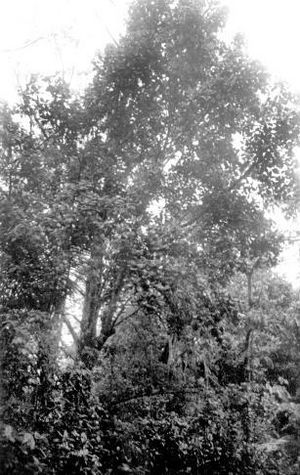Magnolia portoricensis facts for kids
Quick facts for kids Magnolia portoricensis |
|
|---|---|
 |
|
| Jagüilla tree (Magnolia portoricensis) next to a trail at Bosque Estatal de Carite, in Puerto Rico. | |
| Conservation status | |
| Scientific classification | |
| Genus: |
Magnolia
|
| Species: |
portoricensis
|
The Jagüilla (scientific name: Magnolia portoricensis) is a special tree found only in Puerto Rico. It is also known as the Puerto Rico magnolia. This tree is native to the Caribbean region and is considered an endangered species, meaning it is at risk of disappearing forever. You can find it growing in the central and western mountains of Puerto Rico, usually at high elevations between 500 and 925 meters above sea level. It belongs to the Magnolia family, known for its beautiful flowers.
Contents
Where the Jagüilla Lives
The Jagüilla is a tall evergreen tree that can grow up to 25 meters high, which is about as tall as an eight-story building! In Puerto Rico, you can find it in specific state forests in the central region. These include places like Carite, Toro Negro, Guilarte West, and Maricao. It also grows in higher areas like Ciales, Jayuya, and Adjuntas.
This tree thrives in what are called cloud forests. These forests get a lot of rain, usually between 2000 and 4000 millimeters every year. That's a huge amount of water! The Jagüilla prefers to grow on mountain peaks and slopes. It grows best in areas with volcanic soil, which is rich in clay and holds moisture well. The soil is usually a bit acidic to neutral, with a pH between 5 and 7.5. Lots of moisture in the ground is very important for the Jagüilla to grow strong and healthy.
Unique Features of the Jagüilla Tree
The Jagüilla tree has some cool features that make it stand out. Its leaves are large, oval-shaped, and feel waxy. They grow in an alternating pattern along the stem. Unlike a similar type of magnolia, the Jagüilla's leaves and stems are smooth and do not have any hairs.
Flowers and Reproduction
The Jagüilla produces beautiful white flowers that are large, fragrant, and very noticeable. Each flower has both male and female parts, meaning it can produce seeds on its own. Inside the flower, there are many pale yellow carpels, which are the parts that develop into fruit. These are surrounded by many stamens, which produce pollen. It is thought that beetles might help pollinate these flowers, just like they do for other types of magnolias.
Fruit and Seeds
After the flowers are pollinated, the tree grows a cone-shaped fruit. This fruit is green and measures about 3.5 centimeters long and 2.5 centimeters wide. When the fruit is ripe, it cracks open. Inside, you'll find triangular seeds with bright orange, fleshy coverings called arils. These colorful arils help birds notice the seeds and carry them away, spreading them to new places. However, rodents also like to eat these seeds. The seeds contain an oil that helps the young plant grow. Young Jagüilla trees can grow even in shady spots, but they grow very slowly. Their roots also need special fungi to help them absorb nutrients from the soil.
Uses of the Jagüilla Tree
The wood from the Jagüilla tree is of very high quality. Because of this, it is often used to make furniture and lumber. In the past, these trees were used to provide shade for coffee plantations in high mountain areas. Many of these coffee farms have since been abandoned. The oil found in the Magnolia tree can also be used as an ingredient in products like soap, lotions, and perfumes.
Protecting the Jagüilla
Sadly, the Jagüilla tree is currently an endangered species. Its population is shrinking mainly because of deforestation, which is when forests are cut down. Right now, there are no specific programs in Puerto Rico focused on protecting this special tree. It is important to help conserve the Jagüilla so that future generations can continue to enjoy this unique part of Puerto Rico's natural heritage.
Images for kids



